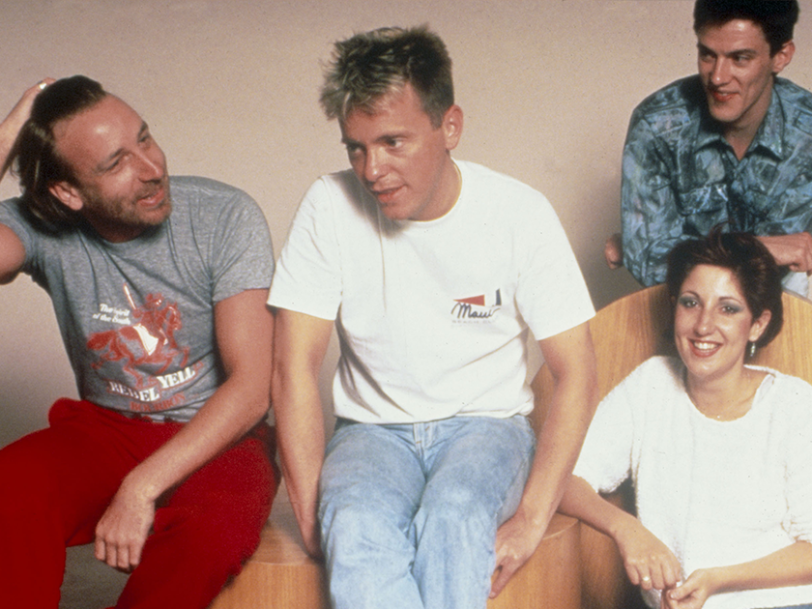It’s safe to say that the process of recording their fifth single, Confusion, took New Order out of their comfort zone. Recorded in New York City with cutting-edge producer Arthur Baker, the song plugged into the futuristic sounds then emerging from the city’s hippest nightclubs, but while the band were happy with the results, they were shocked by their new collaborator’s methodology.
“We thought we’d just go in and write the way we normally did, jamming for hours,” New Order bassist Peter Hook revealed in a 2020 Record Collector interview. “But [Arthur] said, ‘Fuck that, man, we’ll just go in the studio and write something.’ We were like ‘Whaaat?’ It was a nightmare!”
Listen to the best of New Order here.
The backstory: “We liked the sound of contemporary American club records”
New Order’s collaboration with Baker came out of their burgeoning interest in the era’s electronic music and club culture. In 1982, the band became partners in Factory Records’ newly acquired Manchester nightclub, The Haçienda, and their interest in incorporating new technology such as drum machines and sequencers into their trademark, guitar-driven sound had already resulted in their first Top 10 hit, Blue Monday. Having recently fallen in love with another landmark dancefloor-friendly track, all concerned were keen to record more music in a similar vein.
“We liked the sound of contemporary American club records,” Stephen Morris told Record Collector. “We’d done Blue Monday, got rid of Martin [Hannett, Joy Division and early New Order producer] and were quite comfortable with production. We’d heard [Afrika Bambaataa’s] Planet Rock single and loved it, but we’d no idea who produced it. That sounds ridiculous now, when you can just go straight to Google [to find out].”
- Best New Order Songs: 20 Classics From The Factory Floor
- ‘Substance 1987’: Behind The New Order 12” Singles That Changed The World
- Ceremony: The Song That Turned Joy Division Into New Order
The band put some feelers out, but in the end, New York-based filmmaker Michael Shamberg, who looked after Factory’s interests in the US, was responsible for pairing the band up with Planet Rock’s producer, Arthur Baker.
“One of Michael Shamberg’s great skills was what is known today as networking,” Morris said. “Michael was a great socialiser, and before you could say ‘Arthur who?’, Michael had met up with him. A collaboration of some sort was finally arranged.”
The recording: “That’s it, that’s New Order to me, man!”
About to embark on a US tour in support of their second album, Power, Corruption And Lies, New Order met up with Baker in New York. Describing him as “a big bear of a man: think Grizzly Adams, only grizzlier” in his book, Chapter And Verse, Bernard Sumner agreed with Hook that the producer’s MO immediately put them under pressure.
“Arthur was used to working with the kind of experienced session musicians who could churn out stuff practically on demand,” the New Order frontman recalled, “but we didn’t work like that, we weren’t sessioneers with a long track record of hits behind us. We didn’t know what the fuck we were doing and just froze.”
As he was working on UK jazz-funk outfit Freeez’s future hit IOU when New Order arrived, Baker had the group decamp to a Brooklyn rehearsal studio to come up with ideas. However, the band were spooked by the process of spontaneous creation. By the time they joined Baker for the Confusion session proper, they still had precious little to go on.
- Best New Order Albums: All 10 Studio Releases, Ranked And Reviewed
- The Blue Monday Dance Challenge: How New Order Took Over TikTok
- Best Peter Hook Basslines: 10 Defining Joy Division And New Order Riffs
“Eventually, Arthur finished with Freeez, which only left us with a couple of days in the studio,” Sumner remembered. “The person booked after us was James Brown. So, no pressure there. It was a real urban studio, just off Times Square, right in the heart of one of the world’s fastest-paced cities, an operation with a rapid turnover.”
However, with the clock ticking, Baker took charge of the process, and his no-nonsense approach soon rubbed off on the band.
“Arthur was encouraging in his own way,” Sumner noted. “His attitude was ‘either come up with something or fuck off’. We were pushed, but managed to put together a track called Confusion on which everyone contributed to the lyrics, largely because we only had two or three hours to come up with them.”
- Best New Order Lyrics: 10 Classics Written By Bernard Sumner And The Band
- New Order’s Debut Gig: “The Surprise On People’s Faces Was Priceless”
- ‘Bizarre Love Triangle’: How New Order Created Synth-Pop Perfection
In his memoir Substance: Inside New Order, Hook added, “Arthur was doing loads and loads of different rhythms on the 808 [drum machine]. I played a melody line on the keyboard and he took that as well and programmed it up, then Bernard got some more keyboard lines, using some as ideas for the vocal. Then, at Arthur’s insistence, we all chanted ‘Confusion’ then, ‘ratatatatatatatta hey!’ with great gusto, even Rob [Gretton, manager].”
After swapping instruments with Sumner, so that the frontman played bass on the track and Hook played guitar, Hook went back and layered a “Hooky bassline” on top, leaving Baker declaring, “That’s New Order to me, man!”
The video: “It was pretty cutting-edge and made the perfect location”
Indeed, Baker was so pleased with the results that he supplied three remixes – Confused Beats, Confused Instrumental and Confusion (Rough Mix) – for what would become the 12” pressing of the song. In the meantime, all concerned were confident they’d created something special, with another crucial element of Baker’s creative process providing the inspiration for Confusion’s official video, directed by Charles Sturridge.




